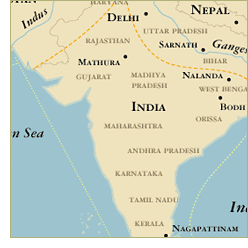

Until roughly the first century C.E., the Buddha was represented in art only by symbols and was not depicted in human form. It is not known exactly when or where the first image of the Buddha was produced, although it is thought to have been either in the area around Mathura, a city in north central India, or in Gandhara, a region in the Peshawar Valley in present-day northern Pakistan and Afghanistan. Although both areas were ruled at the time by the powerful Kushan empire (ca. late 1st – 3rd century C.E.), they are 1,600 miles apart, and their distinct ethnic and cultural histories explain the contrasting appearance of images produced in each place.
The Mathuran style developed out of the indigenous Indic sculptural tradition. Mathuran sculptures usually have hefty, minimally articulated bodies clothed in transparent fabric and a direct, robust quality (Fig. 1); this is in contrast to the more contemplative and naturalistic images created by Gandharan artists (Fig. 2). The standing Buddha in the Gandharan style has half-closed eyes and a muscular body discernible under the folds of drapery. The Gandharan tradition melded a variety of artistic sources but was dominated by Greco-Roman artistic elements, as demonstrated by the toga-like robe, bent-leg stance, and wavy hair of this figure.
Because no one knows what Shakyamuni Buddha looked like, his image was created to convey certain ideas about his life and to indicate his transcendent and supranormal powers. By the fourth century C.E., the hallmarks reflecting these ideals were codified in Indian texts, and they appear, to a certain extent, on all buddha images, regardless of where they were produced. As can be seen in a head of the Buddha from Gandhara (Fig. 3), identifying marks include a bump on the top of the head, signifying his advanced spiritual knowledge; elongated earlobes and shortly cropped hair, the result of Siddhartha removing his earrings and cutting off his long hair when he renounced palace life; and a dot representing a tuft of hair between the eyebrows. Many buddhas also have wheels symbolizing the Buddhist doctrine (dharma) on the palms of their hands and the soles of their feet. Buddhas are attired as monks and usually do not wear any jewelry, although by the eighth century some are depicted crowned and jeweled (Fig. 4).
The Buddha spent most of his life teaching in the eastern Ganges region of India. This area later became dotted with pilgrimage sites associated with his life and home, and some developed into monasteries and universities. These centers attracted devotees from the far corners of Asia; they came to India for religious instruction and pilgrimage and returned home with memories and images of Indian Buddhism. Two of the empires that ruled this region had a particularly strong influence on Buddhist imagery both in India and abroad: the Gupta empire (ca. 4th – 6th century) and the Pala empire (ca. 8th – 12th century).
The Gupta empire unified a large portion of northern India, from coast to coast, and the political stability that ensued encouraged a cultural florescence. The Gupta style, which idealized the body according to literary metaphors (lips like lotus petals, a nose like a parrot's beak, a chin like a mango stone, etc.), was transmitted abroad by images (Fig. 5). The figure's graceful and relaxed posture, downward-looking eyes, and diaphanous robes that reveal the body underneath can be seen on images spread widely throughout Asia. The Gupta stylistic idiom was particularly strong in Southeast Asian regions that had been influenced by Indian statecraft, language, and religion, for example Thailand (Fig. 6).
During the Pala period, pilgrims, monks, and students from all over Asia flocked to the prominent religious centers in eastern India, which had greatly expanded since the Gupta period. The brick temples from this time were decorated with steles, carved, for example, with a form of Avalokiteshvara, the Bodhisattva of Compassion (Fig. 7), which were set into wall niches as part of a program of decoration. The graceful posture, clothing, and jewelry of this richly carved image can be seen on other sculptures in this essay from regions such as the Himalayas (Fig. 8) and Shrivijaya (Fig. 9) that had extensive religious and mercantile exchanges with the Pala empire.
The Pala-ruled areas of northeastern India were the last stronghold of Buddhism in India. In southern India, the popularity of Buddhism had waned by the fifth century C.E., when Hinduism became the dominant religion; the few Buddhist communities and monasteries that survived until the twelfth or thirteenth centuries, was due, in part, to their location near port cities on the maritime trade routes. Their continuous contact with Southeast Asian nations is evident from inscriptions; like Buddhist monuments and institutions in eastern India, those in the south benefited from money sent by distant foreign monarchs eager to prove their piousness and improve their karma. The Asia Society Museum has an impressive eleventh-century southern Indian bronze standing Buddha (Fig. 10), whose flame-shaped symbol of the Buddha's expanded knowledge (ushnisha) atop the head is a distinctive southern Indian feature that spread from India to Sri Lanka, Burma (Myanmar), and Thailand. This type of ushnisha is said to represent the true knowledge that hovers like a flame above the Buddha's head.
|